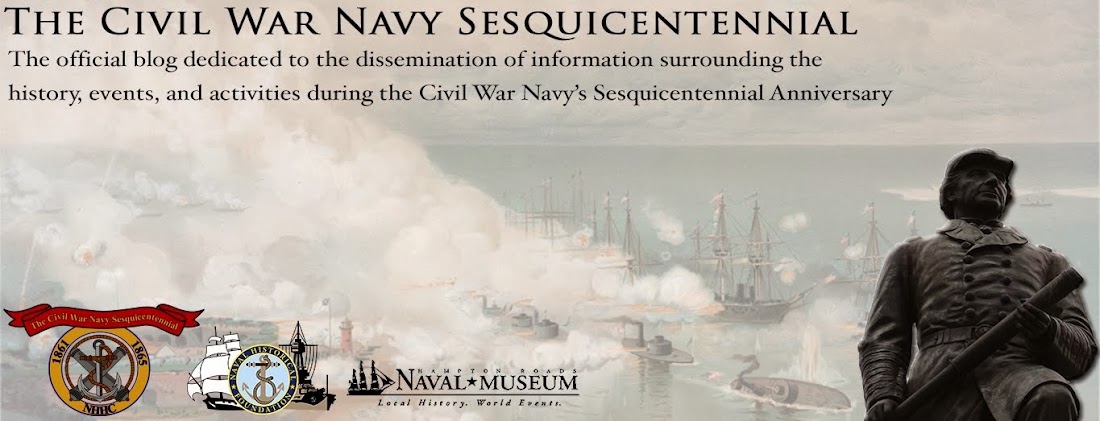It may come as a surprise to some Civil War naval aficionados that there was a ship serving on the South Atlantic Blockading Squadron as famous as Monitor, Hartford, or Alabama. The schooner USS America should be added to that list. The America was small by nineteenth century warship standards. She did not possess iron plates or a steam boiler. No well known officer ever controlled her helm. Nonetheless, her name is legendary to people who compete in sailing regattas.
In 1851, British royalty donated a trophy called the 100 Guinea Cup for the Royal Navy Yacht Club's annual race around the Isle of Wight. Determined to win for the United States, a nine man syndicate known as the New York Yacht Club commissioned the construction of a gaff schooner-rigged yacht. The ship was christened America. After defeating fifteen British ships in front of Queen Victoria, the men brought the Cup to the United States. They donated the trophy to the Club to serve as the award for an international sailing competition. They renamed the cup and competition the "America's Cup," in honor of the yacht’s accomplishment. Every four years, professional sailors and their sponsors compete for the Cup.
In 1851, British royalty donated a trophy called the 100 Guinea Cup for the Royal Navy Yacht Club's annual race around the Isle of Wight. Determined to win for the United States, a nine man syndicate known as the New York Yacht Club commissioned the construction of a gaff schooner-rigged yacht. The ship was christened America. After defeating fifteen British ships in front of Queen Victoria, the men brought the Cup to the United States. They donated the trophy to the Club to serve as the award for an international sailing competition. They renamed the cup and competition the "America's Cup," in honor of the yacht’s accomplishment. Every four years, professional sailors and their sponsors compete for the Cup.

Despite their success, the syndicate sold the schooner to a British lord soon after the race. After passing through a few other hands, the vessel finally landed with another member of British royalty, Henry Deice. According to Edward Sweet, author of The America: War Service of a Racing Yacht, Deice's background was always a mystery. He frequently changed his name in correspondence. It is plausible that he lied about being a British lord. Nonetheless, Deice committed the ship to Confederate service at the beginning of the war to be used a courier/blockade runner out of Jacksonville, Florida.
When Union forces captured Jacksonville, they found the yatch scuttled in the St. Johns River. Determining the vessel was worth saving, the Navy salvaged the schooner and sent her to the Washington Navy Yard for repair. While there, Naval ordnance expert John Dahlgren gave the vessel a 24-pounder and two 12-pounder bronze cannons. Commissioned as USS America, the Navy assigned the fast sailing schooner to the South Atlantic Blockading Squadron. Despite its light battery and small size, America and her commanding officer, Acting Master Jonathan Baker, captured or chased ashore several blockade runners. Her captures included the schooner David Crocket and the steamers Georgina and Stonewall Jackson.
Given the advance in maritime technology, it may seem odd for the Navy to use sailing ships for war service. Since these little vessels (only 170 tons displacement) were fast, drew little water, and required little upkeep, senior officers coveted these ships. Many complained loudly when the Department ordered them off duty.
Given the advance in maritime technology, it may seem odd for the Navy to use sailing ships for war service. Since these little vessels (only 170 tons displacement) were fast, drew little water, and required little upkeep, senior officers coveted these ships. Many complained loudly when the Department ordered them off duty.
After the war, the Navy kept the yacht as a training vessel at the U.S. Naval Academy until it was sold to General Benjamin Butler. She survived until the 1940s. A replicia of the vessel sails on the West Coast of the United States.
The 2013 America's Cup will be held in San Francisco, California.


Cool post, Gordon. Thanks for giving a "shout out" to my Jacksonville post last year. I think a better one is my 14 March 2012 post, "The Enemy Entered Palatka"; there I actually note the finding and raising of the America in the St. Johns River.
ReplyDelete